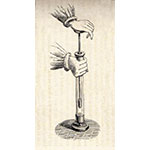Pressure is a physical quantity measured by the ratio of a force to the surface area to which the force is applied. For example, atmospheric pressure (air pressure) is the force exerted by the weight of the air over our heads on a unit of surface area. Atmospheric pressure was long measured in torricellis (torr), a unit of measurement introduced to honor Evangelista Torricelli's (1608-1647) decisive contribution to the discovery of atmospheric pressure. One torr is equal to the pressure exerted by a mercury column with a height of one millimeter (1 torr = 1 mm/Hg); consequently, normal atmospheric pressure at sea level is 760 torr. In 1971, the torr was officially replaced by the pascal, named after the French physicist and philosopher Blaise Pascal (1623-1662), author of fundamental studies on the pressure of fluids. One pascal is equal to 7.5 x 10-3 torr, a pressure equal to that of a mercury column with a height of 7.5 thousandths of a millimeter.








